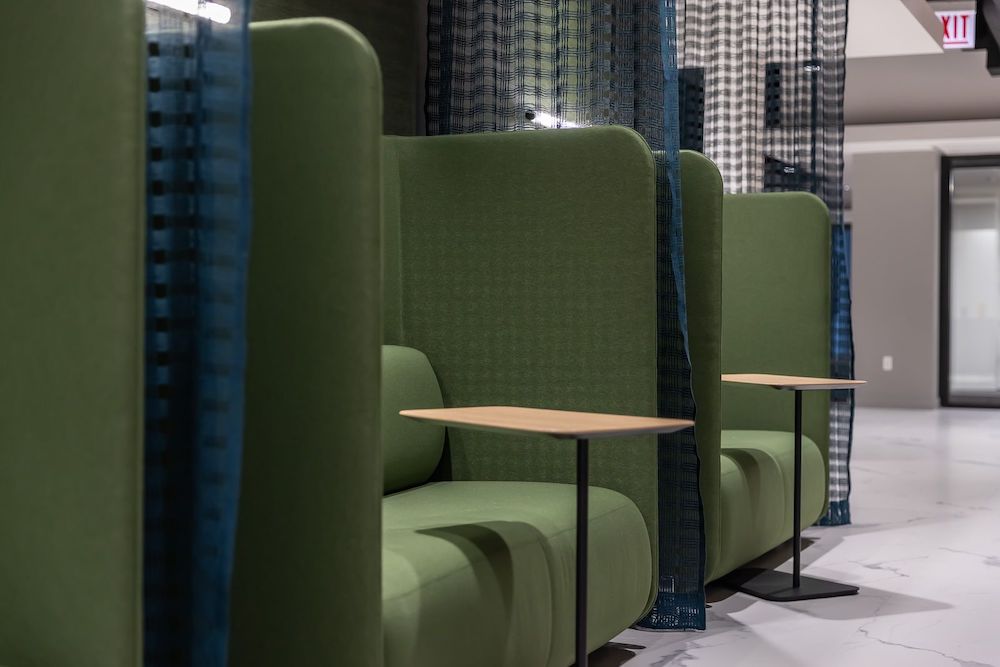Kendra Linton of NELSON Worldwide explores how sensory experiences can support hybrid workplace culture and make room for human-centered design.
– We’re ringing in the new year with more 2023 trends & predictions! See them all here. –

How can sensory experiences support a hybrid workplace? While working from home, employees developed new routines such as brewing a fresh pot of coffee, going for a mid-day walk or sitting in a comfortable chair to work. While we know that workplace design is the intersection of brand, culture and the built environment, sensory experiences offer an opportunity to layer in emotional connections throughout the space that can help employees develop routines in the workplace to compliment those formed at home. Sensory experiences support hybrid workplace culture by encouraging employees to connect, engage and evolve together, making room for human-centered design.
Making Connections
Designing spaces for connection has taken on a new meaning since the pandemic. Before 2020, connection in workplace design was often approached through the lens of collaboration. Typically, collaborative spaces were centrally located with flexible furniture solutions. While these space typologies are still relevant, they have taken on a different form in hybrid workplace planning scenarios.
Designing to support connection in the hybrid workplace may mean reconsidering scale and privacy. Examples of this include Zoom rooms and small flexible conference spaces that act as portals to connect with remote teammates. Some sensory design considerations for these spaces might include:
- Tactile Materials: Designing these spaces with welcoming seating groups upholstered in tactile materials which will attract employees and create routines based in comfort and convenience.
- Acoustic Privacy: These spaces can support acoustic privacy using drapery and plush upholstery.
- Ambient Lighting: Lighting can be controlled by the user and may include ancillary items such as a lamp to add a sense of comfort and familiarity to the workplace.
These experiences layer in sensory considerations of touch, sound and sight while empowering employees to connect in a way that makes sense for their workstyle.

Engaging Spaces
Creating spaces that allow for personalization, comfort, and socialization are essential to keeping employees fully engaged. Hybrid employees want to feel a sense of belonging when they are in the office. Workplaces often integrate hoteling workstations which provide an opportunity to integrate some of these sensory considerations:
- Personalization: Adding open shelving around hoteling workstations and encouraging employees to add their personal effects helps hybrid employees feel a sense of belonging and place. (This also plays into socialization as they can share a common space with co-workers.)
- Control: Studies have shown that employees work best in an environment that they can control. Allowing some degree of control with lighting and thermal comfort will help employees tune their space to best suit their needs.
- Comfort: Ergonomic furniture that promotes good posture can encourage employees to stay alert and engaged.
While considerations of personalization and comfort support employee morale, socialization is key to engagement and can be supported through magnetic spaces such as a barista bar or library space. Each of these amenities supports different working styles while aroma, acoustics and visual stimulation play a supporting sensory role.

Experience Evolution
As employee needs evolve so too can the spaces that support them. Allowing room for wellness, flexibility and technology experimentation can support employee growth:
- Wellness: Places for wellness and respite connect employees with a sense of calm. These environments are typically designed with natural materials and include plants which are proven to release serotonin.
- Experimentation: Sensory experiences can also be influenced by a space that is easily reconfigurable. Flexible furniture and technology allow employees to experiment with inclusive configurations that can fit their teams needs as they evolve over time.
Sensory experiences are the emotional foundation of the workplace, and the shifting landscape of design offers an exciting opportunity for us to consider how we might integrate these experiences into hybrid workplace environments as we design for the office of tomorrow.

